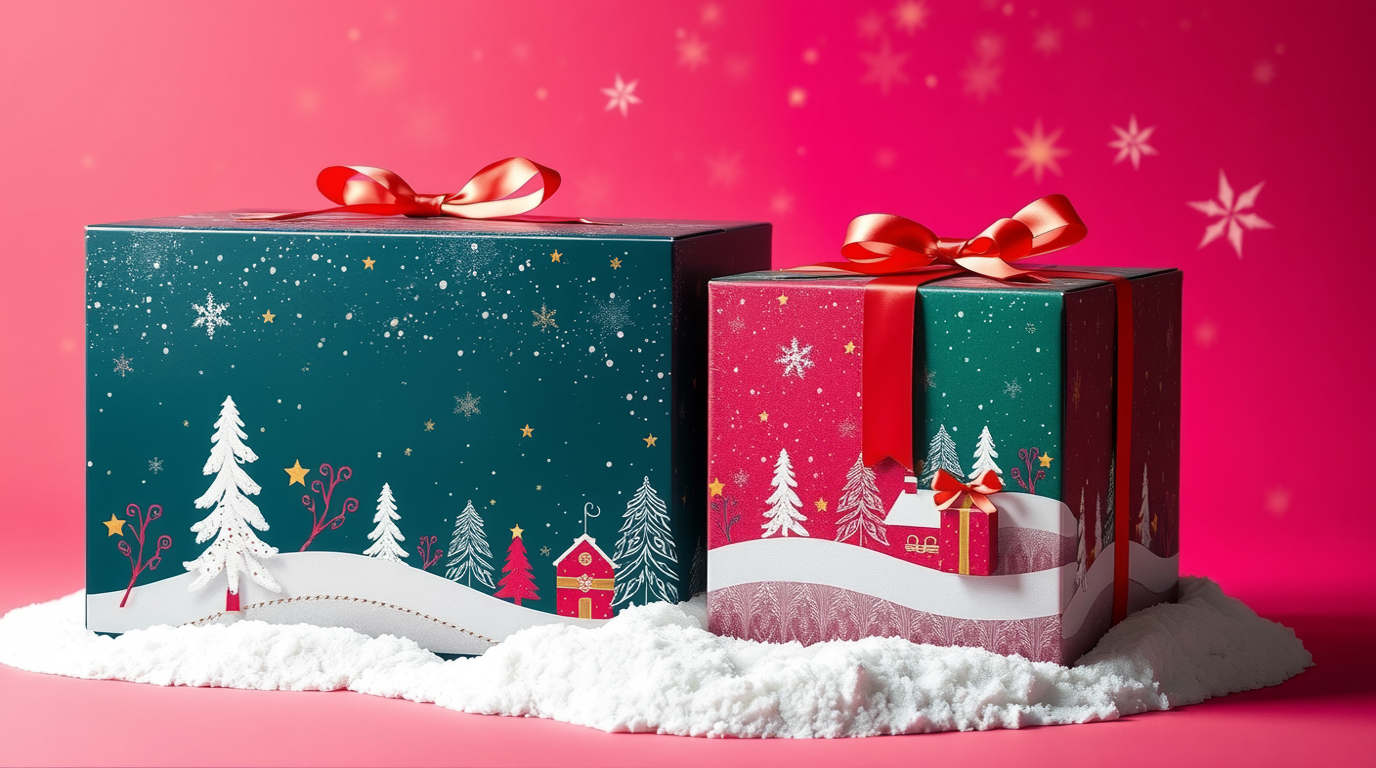Did you know that customers spent a staggering $789 billion on holiday purchases in 2020 alone? Corporate packaging design becomes crucial when you consider that 20-30% of year-round sales across all industries are attributed to Christmas-related purchases.
However, many brands fail to capitalise on this opportunity because they start planning too late. The packaging industry’s peak season begins in early September and continues until Christmas, whilst many consumers begin their holiday shopping as early as October. This creates an inevitable bottleneck that affects design quality, production timelines, and ultimately, sales potential.
For marketing managers and procurement teams, the solution is straightforward: start your festive packaging planning in Q3. Specifically, collaborating with packaging suppliers approximately 12 weeks in advance represents the best-case scenario, allowing sufficient time for thoughtful design briefs, budget approvals, and production scheduling for year-end gifts, branded packets, calendars, and Chinese New Year items.
This guide provides a strategic roadmap for navigating the complexities of seasonal packaging design, from initial planning through execution.
Why Q3 Is the Best Time to Start Planning
In Singapore, planning festive packaging in Q3 gives businesses a key advantage. With the rainy season starting in October and year-end demand rising, designing packaging between July and September helps avoid weather delays, secure supplier timelines, and align with festive marketing for smooth peak season execution.
Avoiding festive season production delays
The year-end festive season often causes major bottlenecks in packaging production. In Singapore, demand spikes ahead of Deepavali, Christmas, and New Year, with global supply chains also tightening during this period. With 82% of shoppers starting their holiday purchases before or during Thanksgiving weekend, businesses that delay packaging preparations until November risk missing out on early sales momentum.
Production lead times grow longer in Q4 due to regional material shortages and international shipping delays. For branded packaging, we recommend placing orders at least six weeks in advance. Custom-designed items may require even more time. Companies that wait too long often face a difficult choice: rush a subpar design or miss peak-season opportunities entirely.
Aligning with internal marketing and procurement cycles
Q3 represents an ideal planning period as it bridges summer activities and year-end campaigns. During July-September, marketing teams can assess current consumer trends while procurement departments still have budget flexibility. Additionally, this period typically sees:
- Fewer staff on holiday leave
- Time to gather feedback on design concepts and make necessary refinements
- Opportunity to coordinate packaging with broader holiday marketing strategies
Starting early essentially transforms packaging from a last-minute necessity into a strategic marketing asset.
Securing supplier timelines before peak season
Regular communication with suppliers during Q3 allows both parties to plan production and logistics more efficiently. Manufacturers prioritise orders based on submission timing, meaning early planners secure optimal production slots and potentially better rates. Rather than competing for attention during the industry’s busiest period, Q3 planning establishes your requirements before the rush begins.
Building a Strategic Packaging Plan
Successful corporate packaging design requires more than creative ideas, it demands strategic planning. Creating a comprehensive roadmap ensures your festive packaging becomes a powerful marketing tool alongside serving its functional purpose.
Setting clear campaign goals and KPIs
Effective packaging campaigns start with measurable objectives. Packaging KPIs should directly link to broader business goals:
- Quality metrics (percentage of defective products)
- Customer satisfaction metrics (feedback on packaging design)
- Sales performance indicators (impact of packaging on revenue)
Consequently, tracking these metrics helps identify strengths and weaknesses, allowing companies to refine strategies for superior outcomes. Moreover, measuring packaging design effectiveness through market research provides valuable insights into how packaging influences purchasing decisions.
Creating a realistic timeline from Q3 to Q1
The single most important action for festive packaging success is starting early. Ideally, begin collaborating with suppliers approximately 12 weeks before needed. Subsequently, develop a production schedule that accounts for:
Firstly, conceptualization and design phases (July-August) Secondly, approvals and refinements (September) Finally, production and logistics (October-November)
This timeline ensures you avoid the industry peak season that begins in early September, securing your place in production queues ahead of competitors.
Budgeting for design, production, and logistics
Packaging costs can vary widely depending on design complexity, materials, and order volume. While bespoke designs from large agencies can command premium rates, many businesses in Singapore achieve professional results through cost-effective partners like PrintandPack.
Material choice also plays a big role in cost. For example, recycled kraft paper or cardboard is often more budget-friendly than rigid or moulded plastics, and still aligns with eco-conscious branding.
To maximise your packaging budget without sacrificing quality:
- Optimise packaging dimensions to reduce material usage and shipping fees
- Use simple designs with mono-print logos or single-colour prints for better cost efficiency
- Increase print quantities to enjoy lower per-unit pricing
Assigning roles: marketing, design, procurement
The Packaging Designer works with materials, shapes, colours, and graphics to enhance user experience and strengthen brand identity. Furthermore, designers collaborate closely with marketing teams to ensure the company’s product and brand are well represented through packaging materials.
Make a comprehensive packaging plan that aligns with your marketing goals and timeline by assigning clear responsibilities to each department, marketing handles brand messaging, designers manage creative execution, and procurement secures optimal supplier relationships and production slots.

Creative Packaging Design Ideas for Festive Campaigns
Corporate packaging design directly impacts consumer purchasing decisions, with 30% of shelf appeal attributed to eye-catching presentation. Creating standout festive packaging requires thoughtful planning alongside creative execution.
Incorporating seasonal themes and colours
Festive packaging design transforms ordinary products into memorable experiences. For Christmas, traditional red and green evoke holiday spirit, whilst black and gold combinations signal elegance and luxury. Alternatively, rustic kraft designs with mono-colour prints create organic warmth that connects with consumers. Seasonal packaging evokes nostalgia and sentimentality, as demonstrated by Coca-Cola’s annual Christmas campaign featuring festively decorated bottles.
Packaging design examples from past campaigns
Standout festive packaging campaigns include Starbucks’ red backgrounds with golden accents that complemented their green logo. Likewise, Amazon created interactive toy catalogues with wish lists and stickers, generating sales through nostalgic experiences.
Special considerations for Chinese New Year (CNY)
Chinese New Year packaging demands cultural sensitivity. Red and gold remain essential, symbolising luck and prosperity. Common design elements include zodiac animals, the character ‘福’ (good fortune), lanterns, and plum blossoms, each carrying deep festive meaning. Premium finishing techniques like gold foil stamping, embossing, and UV printing are often used to enhance visual appeal.
Consumers and businesses are increasingly seeking complete CNY gifting sets for maximum impact. This includes custom box printing for hampers, branded calendars, festive red packets, and reusable canvas bags, all available in one shot from us, PrintandPack. These cohesive, impressive packaged sets help make a lasting impression and strengthen brand presence during the festive season.
How to write a packaging design description for briefs
Effective packaging briefs must clearly communicate seasonal requirements. Include specific colour references, required cultural elements, and production techniques. Above all, provide realistic timelines acknowledging Chinese New Year’s cultural significance.
Balancing creativity with production feasibility
Although creative designs capture attention, functionality remains paramount. Consider technical limitations early in the design process. As companies increasingly prioritise sustainability, opt for recyclable, biodegradable materials that minimise environmental impact.
Executing with Suppliers and Internal Teams
Bringing your festive packaging plan to life depends on how well internal teams and external suppliers work together. Clear communication and efficient coordination ensure designs are delivered on time, on budget, and aligned with campaign goals.
It begins with a well-prepared packaging brief. This should outline specifications, brand guidelines, quantity requirements, and delivery deadlines, while also including competitor visuals, shelf context, and insights into shopper behaviour.
Sharing these details early helps suppliers secure production slots ahead of the festive rush and design packaging that resonates with your audience.
Smooth approvals are just as important. Establishing clear review stages for design, brand, and compliance teams, and standardising them through templates, keeps the process consistent, reduces errors, and shortens timelines.
Once production begins, maintaining visibility across key milestones is critical. Pre-production checks, in-process quality reviews, and final pre-shipment inspections allow teams to spot issues early and document handover points, ensuring accountability throughout the supply chain.
Finally, coordinating closely with marketing ensures packaging delivery aligns with campaign launches. By centralising creative assets and syncing schedules, you create a seamless rollout where packaging and promotions work hand in hand for maximum festive impact.
Conclusion
Mastering festive corporate packaging starts with early, strategic planning. Q3, from July to September, is the ideal window to brief designs, secure production slots, and avoid Q4 bottlenecks. With consumers beginning holiday shopping as early as October, businesses that plan ahead gain a clear advantage in meeting demand and delivering standout packaging on time.
Festive packaging is more than just a box. It is a marketing tool that reinforces brand identity and influences buying decisions. From culturally sensitive Chinese New Year designs to seamless supplier coordination, companies that treat packaging as a strategic priority turn seasonal campaigns into impactful brand experiences. Get ahead this festive season with custom packaging solutions from PrintandPack and bring your brand to life with every unboxing.
FAQs
When is the best time to start planning festive packaging design?
The ideal time to begin planning festive packaging design is during Q3 (July-September). This allows ample time for design, approvals, and production before the holiday rush begins.
How can I make my festive packaging stand out?
To make your festive packaging stand out, incorporate seasonal themes and colours, use eye-catching designs, and consider special finishes like gold foil stamping or embossing. Balance creativity with functionality and cultural sensitivity, especially for events like Chinese New Year.
What are some key considerations for Chinese New Year packaging?
For Chinese New Year packaging, focus on using red and gold colours, which symbolise luck and wealth. Include cultural elements such as zodiac animals, the character ‘福’ (good fortune), lanterns, and plum blossoms. Consider personalisation options, as consumers increasingly value customised CNY packaging for gifting.
How can I ensure my packaging design is produced on time for the festive season?
To ensure timely production, start collaborating with suppliers about 12 weeks before you need the packaging. Create a realistic timeline from Q3 to Q1, secure production slots early, and maintain clear communication with your supplier throughout the process.
What should I include in a packaging design brief for my supplier?
A comprehensive packaging design brief should include product specifications, brand guidelines, quantity requirements, production deadlines, and visual references. Explain your target audience’s shopping behaviour and provide context about competitors and shelf placement. Clear communication in your brief helps ensure the final product meets your expectations.






